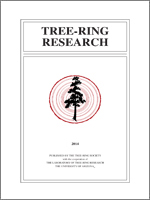This study focuses on tropical tree growth rates in Western Kenya. The dendrochronological potential of each study species was determined by visual examination of rings, and then cumulative growth trajectories for diameter were synthesized for species of sufficient sample size (n ≥ 3), based on ring-width chronologies. The 14 tree species considered were: Acacia mearnsii, Bridelia micrantha, Combretum molle, Croton macrostachyus, Cupressus lustianica, Eucalyptus camaldulensis, Eucalyptus grandis, Eucalyptus saligna, Grevillea robusta, Mangifera indica, Markhamia lutea, Persia Americana, Syzygium cumini, and Trilepisium madagascariensis. The species with the highest dendrochronological potential included Acacia mearnsii, Cupressus lusitanica, the Eucalyptus spp. and Mangifera indica, which are all non-native species that successfully crossdated. The results also indicated that the species with highest dendrochronological potential had strong radial growth synchrony, which was reflected in high inter-tree correlation and (or) high growth variance explained by the first principal component axis. Furthermore, A. mearnsii and E. camaldulensis were sensitive to annual precipitation and moisture index. The species with the lowest dendrochronological potential were Grevillea robusta and Markhamia lutea. In terms of productivity, the three fastest growing species in the study, based on annual diameter increment, were Eucalyptus camaldulensis, Eucalyptus grandis, and Acacia mearnsii. This study also has great potential to extrapolate historical patterns of diameter growth to understanding annual aboveground biomass and carbon dynamics in Western Kenya.
How to translate text using browser tools
1 July 2014
Dendrochronological Potential and Productivity of Tropical Tree Species in Western Kenya
Eric T. David,
Sophan Chhin,
David Skole
ACCESS THE FULL ARTICLE

Tree-Ring Research
Vol. 70 • No. 2
July 2014
Vol. 70 • No. 2
July 2014
dendrochronology
Kenya
productivity
tropical ecosystems




